Social Entrepreneurship: Fairphone Smartphone Case Study
VerifiedAdded on 2023/01/16
|11
|2021
|30
AI Summary
The report is about social entrepreneurship with its main focus on Fairphone smartphone, a Netherlands based company which practices the same. It covers the characteristics and traits of social entrepreneurs and the challenges they face based on Fairphone Smartphone.
Contribute Materials
Your contribution can guide someone’s learning journey. Share your
documents today.

Name:
Title:
Institution:
Title:
Institution:
Secure Best Marks with AI Grader
Need help grading? Try our AI Grader for instant feedback on your assignments.
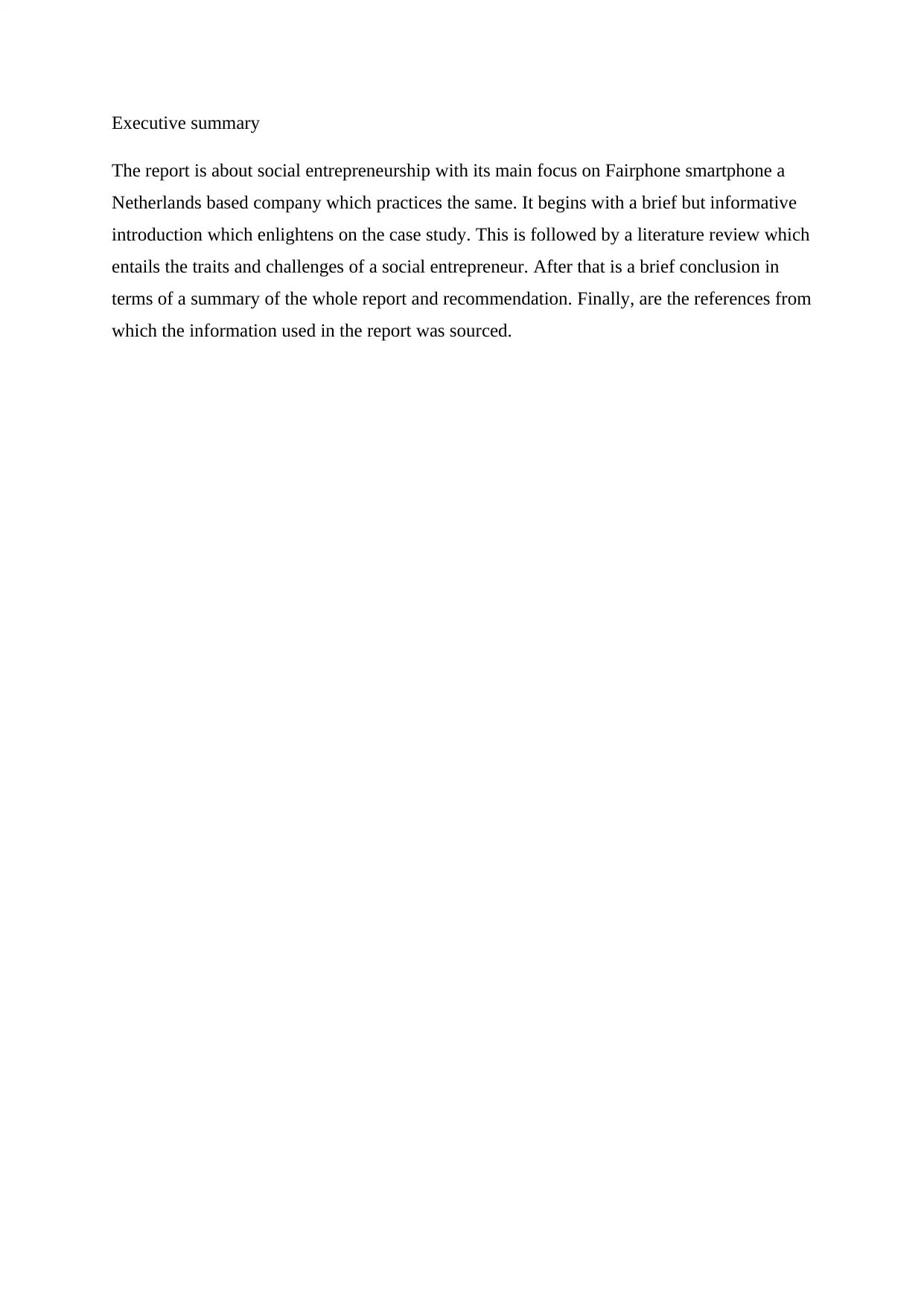
Executive summary
The report is about social entrepreneurship with its main focus on Fairphone smartphone a
Netherlands based company which practices the same. It begins with a brief but informative
introduction which enlightens on the case study. This is followed by a literature review which
entails the traits and challenges of a social entrepreneur. After that is a brief conclusion in
terms of a summary of the whole report and recommendation. Finally, are the references from
which the information used in the report was sourced.
The report is about social entrepreneurship with its main focus on Fairphone smartphone a
Netherlands based company which practices the same. It begins with a brief but informative
introduction which enlightens on the case study. This is followed by a literature review which
entails the traits and challenges of a social entrepreneur. After that is a brief conclusion in
terms of a summary of the whole report and recommendation. Finally, are the references from
which the information used in the report was sourced.

Contents
Introduction................................................................................................................................4
Literature review........................................................................................................................5
Characteristics and traits of social entrepreneurs...................................................................5
Challenges facing social entrepreneurship.............................................................................6
Conclusion..................................................................................................................................9
References................................................................................................................................10
Introduction................................................................................................................................4
Literature review........................................................................................................................5
Characteristics and traits of social entrepreneurs...................................................................5
Challenges facing social entrepreneurship.............................................................................6
Conclusion..................................................................................................................................9
References................................................................................................................................10
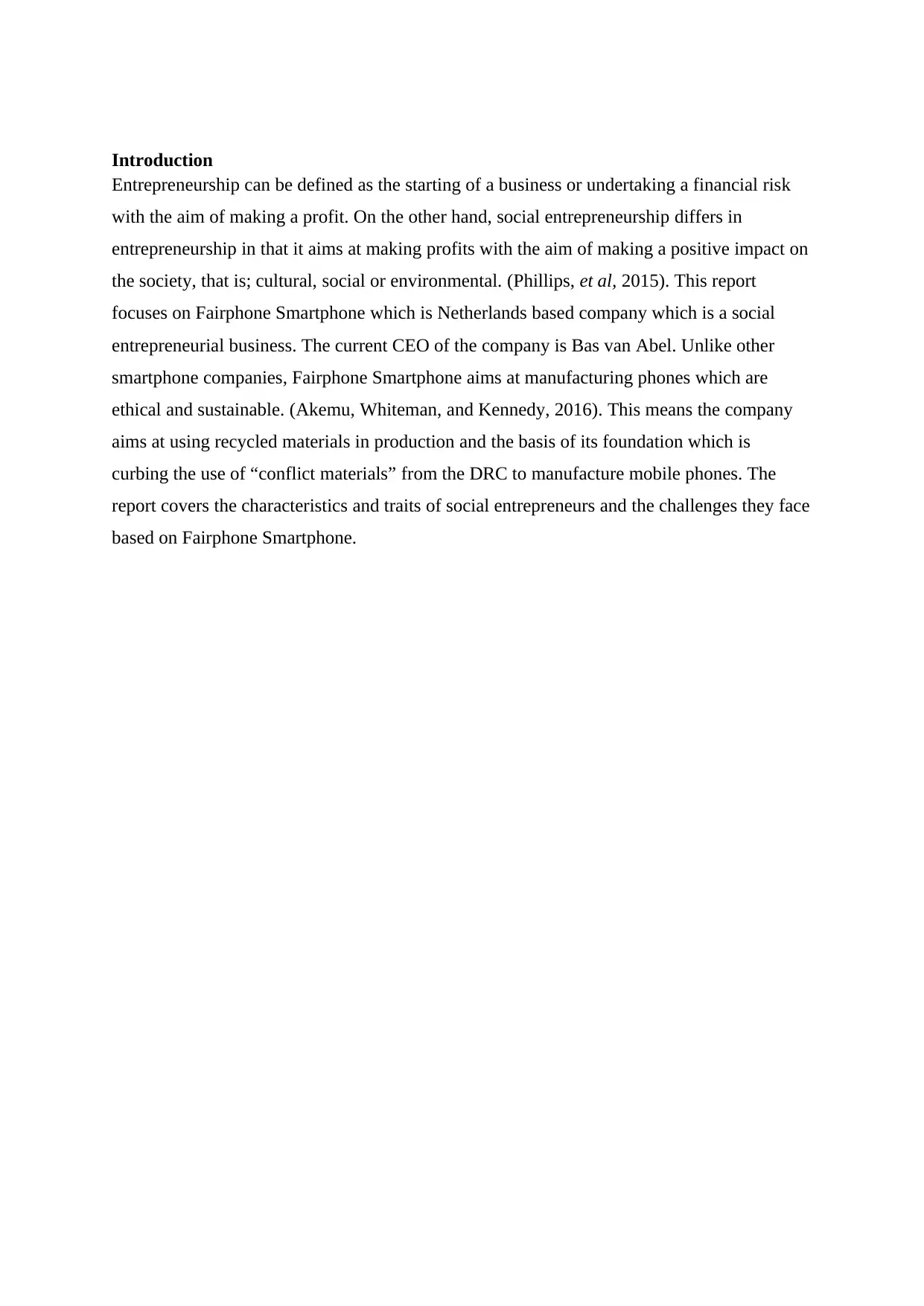
Introduction
Entrepreneurship can be defined as the starting of a business or undertaking a financial risk
with the aim of making a profit. On the other hand, social entrepreneurship differs in
entrepreneurship in that it aims at making profits with the aim of making a positive impact on
the society, that is; cultural, social or environmental. (Phillips, et al, 2015). This report
focuses on Fairphone Smartphone which is Netherlands based company which is a social
entrepreneurial business. The current CEO of the company is Bas van Abel. Unlike other
smartphone companies, Fairphone Smartphone aims at manufacturing phones which are
ethical and sustainable. (Akemu, Whiteman, and Kennedy, 2016). This means the company
aims at using recycled materials in production and the basis of its foundation which is
curbing the use of “conflict materials” from the DRC to manufacture mobile phones. The
report covers the characteristics and traits of social entrepreneurs and the challenges they face
based on Fairphone Smartphone.
Entrepreneurship can be defined as the starting of a business or undertaking a financial risk
with the aim of making a profit. On the other hand, social entrepreneurship differs in
entrepreneurship in that it aims at making profits with the aim of making a positive impact on
the society, that is; cultural, social or environmental. (Phillips, et al, 2015). This report
focuses on Fairphone Smartphone which is Netherlands based company which is a social
entrepreneurial business. The current CEO of the company is Bas van Abel. Unlike other
smartphone companies, Fairphone Smartphone aims at manufacturing phones which are
ethical and sustainable. (Akemu, Whiteman, and Kennedy, 2016). This means the company
aims at using recycled materials in production and the basis of its foundation which is
curbing the use of “conflict materials” from the DRC to manufacture mobile phones. The
report covers the characteristics and traits of social entrepreneurs and the challenges they face
based on Fairphone Smartphone.
Paraphrase This Document
Need a fresh take? Get an instant paraphrase of this document with our AI Paraphraser
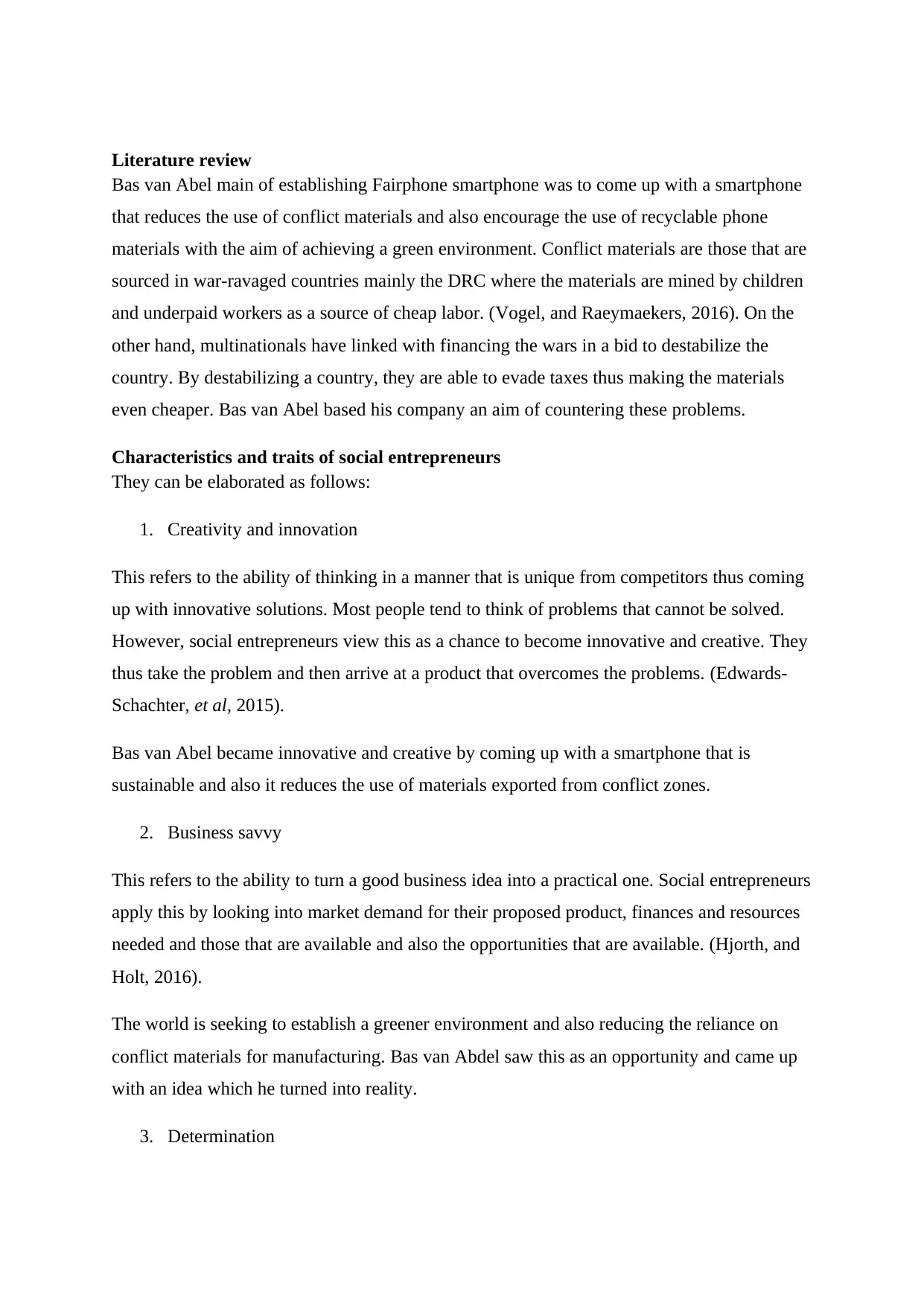
Literature review
Bas van Abel main of establishing Fairphone smartphone was to come up with a smartphone
that reduces the use of conflict materials and also encourage the use of recyclable phone
materials with the aim of achieving a green environment. Conflict materials are those that are
sourced in war-ravaged countries mainly the DRC where the materials are mined by children
and underpaid workers as a source of cheap labor. (Vogel, and Raeymaekers, 2016). On the
other hand, multinationals have linked with financing the wars in a bid to destabilize the
country. By destabilizing a country, they are able to evade taxes thus making the materials
even cheaper. Bas van Abel based his company an aim of countering these problems.
Characteristics and traits of social entrepreneurs
They can be elaborated as follows:
1. Creativity and innovation
This refers to the ability of thinking in a manner that is unique from competitors thus coming
up with innovative solutions. Most people tend to think of problems that cannot be solved.
However, social entrepreneurs view this as a chance to become innovative and creative. They
thus take the problem and then arrive at a product that overcomes the problems. (Edwards-
Schachter, et al, 2015).
Bas van Abel became innovative and creative by coming up with a smartphone that is
sustainable and also it reduces the use of materials exported from conflict zones.
2. Business savvy
This refers to the ability to turn a good business idea into a practical one. Social entrepreneurs
apply this by looking into market demand for their proposed product, finances and resources
needed and those that are available and also the opportunities that are available. (Hjorth, and
Holt, 2016).
The world is seeking to establish a greener environment and also reducing the reliance on
conflict materials for manufacturing. Bas van Abdel saw this as an opportunity and came up
with an idea which he turned into reality.
3. Determination
Bas van Abel main of establishing Fairphone smartphone was to come up with a smartphone
that reduces the use of conflict materials and also encourage the use of recyclable phone
materials with the aim of achieving a green environment. Conflict materials are those that are
sourced in war-ravaged countries mainly the DRC where the materials are mined by children
and underpaid workers as a source of cheap labor. (Vogel, and Raeymaekers, 2016). On the
other hand, multinationals have linked with financing the wars in a bid to destabilize the
country. By destabilizing a country, they are able to evade taxes thus making the materials
even cheaper. Bas van Abel based his company an aim of countering these problems.
Characteristics and traits of social entrepreneurs
They can be elaborated as follows:
1. Creativity and innovation
This refers to the ability of thinking in a manner that is unique from competitors thus coming
up with innovative solutions. Most people tend to think of problems that cannot be solved.
However, social entrepreneurs view this as a chance to become innovative and creative. They
thus take the problem and then arrive at a product that overcomes the problems. (Edwards-
Schachter, et al, 2015).
Bas van Abel became innovative and creative by coming up with a smartphone that is
sustainable and also it reduces the use of materials exported from conflict zones.
2. Business savvy
This refers to the ability to turn a good business idea into a practical one. Social entrepreneurs
apply this by looking into market demand for their proposed product, finances and resources
needed and those that are available and also the opportunities that are available. (Hjorth, and
Holt, 2016).
The world is seeking to establish a greener environment and also reducing the reliance on
conflict materials for manufacturing. Bas van Abdel saw this as an opportunity and came up
with an idea which he turned into reality.
3. Determination
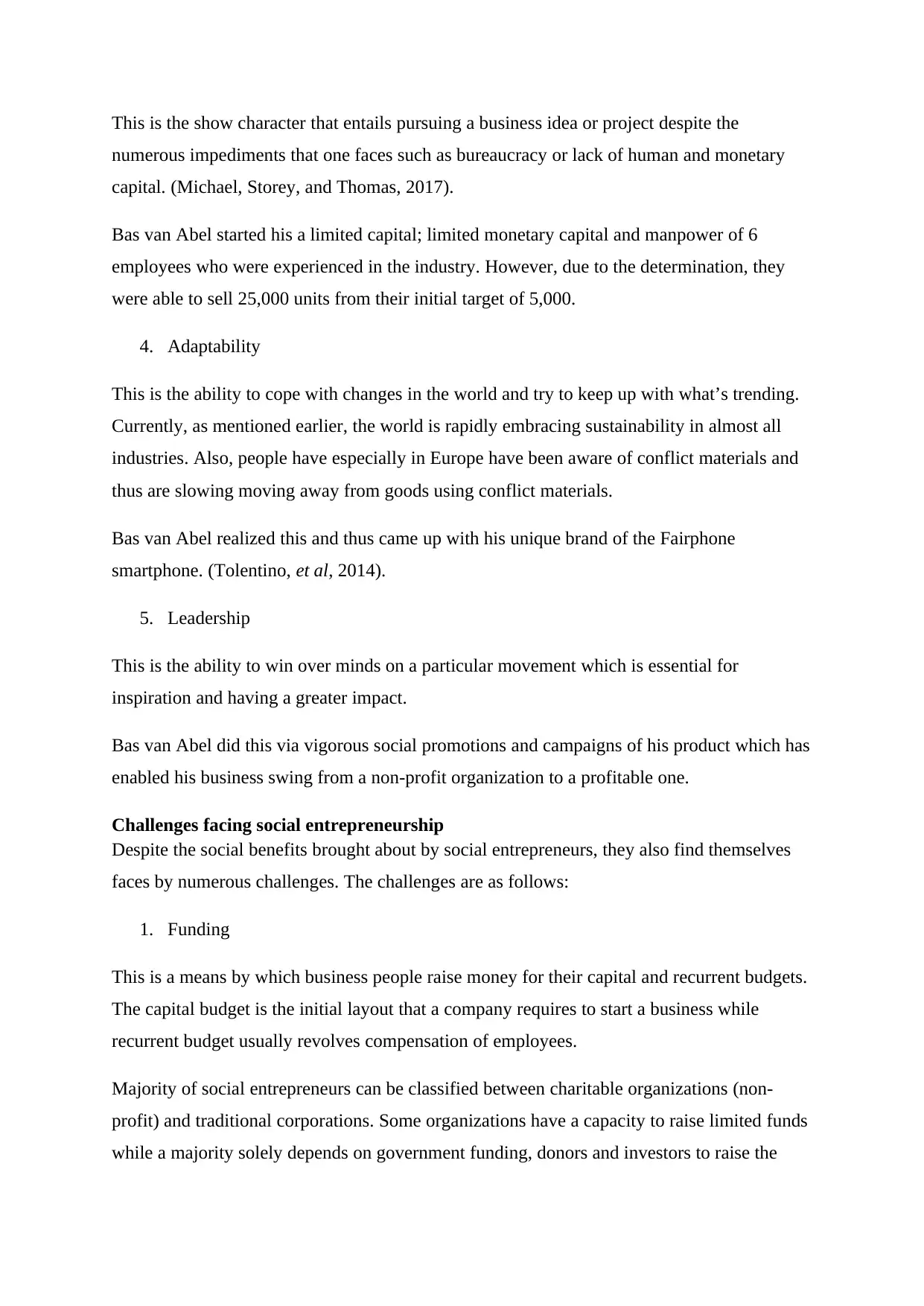
This is the show character that entails pursuing a business idea or project despite the
numerous impediments that one faces such as bureaucracy or lack of human and monetary
capital. (Michael, Storey, and Thomas, 2017).
Bas van Abel started his a limited capital; limited monetary capital and manpower of 6
employees who were experienced in the industry. However, due to the determination, they
were able to sell 25,000 units from their initial target of 5,000.
4. Adaptability
This is the ability to cope with changes in the world and try to keep up with what’s trending.
Currently, as mentioned earlier, the world is rapidly embracing sustainability in almost all
industries. Also, people have especially in Europe have been aware of conflict materials and
thus are slowing moving away from goods using conflict materials.
Bas van Abel realized this and thus came up with his unique brand of the Fairphone
smartphone. (Tolentino, et al, 2014).
5. Leadership
This is the ability to win over minds on a particular movement which is essential for
inspiration and having a greater impact.
Bas van Abel did this via vigorous social promotions and campaigns of his product which has
enabled his business swing from a non-profit organization to a profitable one.
Challenges facing social entrepreneurship
Despite the social benefits brought about by social entrepreneurs, they also find themselves
faces by numerous challenges. The challenges are as follows:
1. Funding
This is a means by which business people raise money for their capital and recurrent budgets.
The capital budget is the initial layout that a company requires to start a business while
recurrent budget usually revolves compensation of employees.
Majority of social entrepreneurs can be classified between charitable organizations (non-
profit) and traditional corporations. Some organizations have a capacity to raise limited funds
while a majority solely depends on government funding, donors and investors to raise the
numerous impediments that one faces such as bureaucracy or lack of human and monetary
capital. (Michael, Storey, and Thomas, 2017).
Bas van Abel started his a limited capital; limited monetary capital and manpower of 6
employees who were experienced in the industry. However, due to the determination, they
were able to sell 25,000 units from their initial target of 5,000.
4. Adaptability
This is the ability to cope with changes in the world and try to keep up with what’s trending.
Currently, as mentioned earlier, the world is rapidly embracing sustainability in almost all
industries. Also, people have especially in Europe have been aware of conflict materials and
thus are slowing moving away from goods using conflict materials.
Bas van Abel realized this and thus came up with his unique brand of the Fairphone
smartphone. (Tolentino, et al, 2014).
5. Leadership
This is the ability to win over minds on a particular movement which is essential for
inspiration and having a greater impact.
Bas van Abel did this via vigorous social promotions and campaigns of his product which has
enabled his business swing from a non-profit organization to a profitable one.
Challenges facing social entrepreneurship
Despite the social benefits brought about by social entrepreneurs, they also find themselves
faces by numerous challenges. The challenges are as follows:
1. Funding
This is a means by which business people raise money for their capital and recurrent budgets.
The capital budget is the initial layout that a company requires to start a business while
recurrent budget usually revolves compensation of employees.
Majority of social entrepreneurs can be classified between charitable organizations (non-
profit) and traditional corporations. Some organizations have a capacity to raise limited funds
while a majority solely depends on government funding, donors and investors to raise the
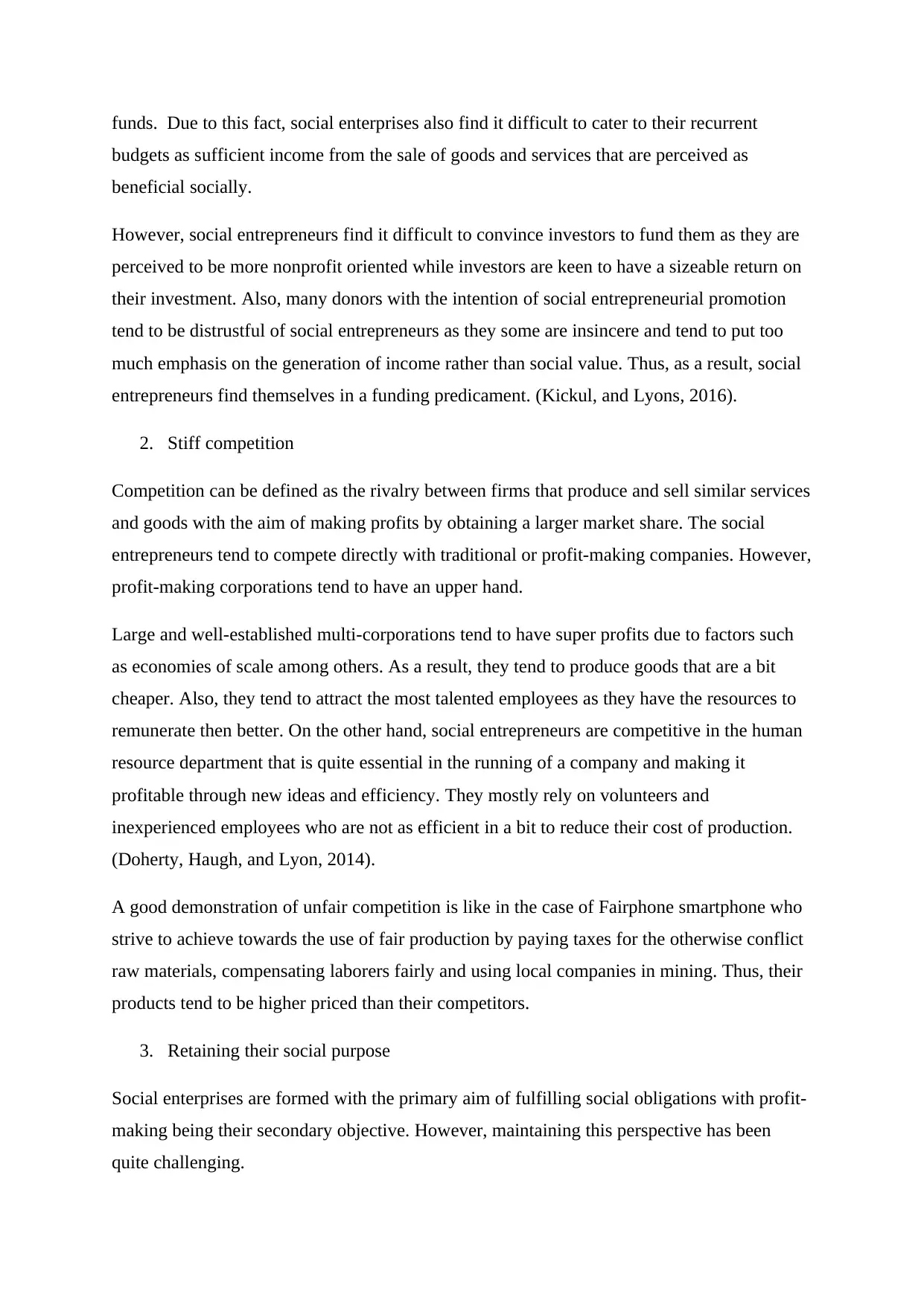
funds. Due to this fact, social enterprises also find it difficult to cater to their recurrent
budgets as sufficient income from the sale of goods and services that are perceived as
beneficial socially.
However, social entrepreneurs find it difficult to convince investors to fund them as they are
perceived to be more nonprofit oriented while investors are keen to have a sizeable return on
their investment. Also, many donors with the intention of social entrepreneurial promotion
tend to be distrustful of social entrepreneurs as they some are insincere and tend to put too
much emphasis on the generation of income rather than social value. Thus, as a result, social
entrepreneurs find themselves in a funding predicament. (Kickul, and Lyons, 2016).
2. Stiff competition
Competition can be defined as the rivalry between firms that produce and sell similar services
and goods with the aim of making profits by obtaining a larger market share. The social
entrepreneurs tend to compete directly with traditional or profit-making companies. However,
profit-making corporations tend to have an upper hand.
Large and well-established multi-corporations tend to have super profits due to factors such
as economies of scale among others. As a result, they tend to produce goods that are a bit
cheaper. Also, they tend to attract the most talented employees as they have the resources to
remunerate then better. On the other hand, social entrepreneurs are competitive in the human
resource department that is quite essential in the running of a company and making it
profitable through new ideas and efficiency. They mostly rely on volunteers and
inexperienced employees who are not as efficient in a bit to reduce their cost of production.
(Doherty, Haugh, and Lyon, 2014).
A good demonstration of unfair competition is like in the case of Fairphone smartphone who
strive to achieve towards the use of fair production by paying taxes for the otherwise conflict
raw materials, compensating laborers fairly and using local companies in mining. Thus, their
products tend to be higher priced than their competitors.
3. Retaining their social purpose
Social enterprises are formed with the primary aim of fulfilling social obligations with profit-
making being their secondary objective. However, maintaining this perspective has been
quite challenging.
budgets as sufficient income from the sale of goods and services that are perceived as
beneficial socially.
However, social entrepreneurs find it difficult to convince investors to fund them as they are
perceived to be more nonprofit oriented while investors are keen to have a sizeable return on
their investment. Also, many donors with the intention of social entrepreneurial promotion
tend to be distrustful of social entrepreneurs as they some are insincere and tend to put too
much emphasis on the generation of income rather than social value. Thus, as a result, social
entrepreneurs find themselves in a funding predicament. (Kickul, and Lyons, 2016).
2. Stiff competition
Competition can be defined as the rivalry between firms that produce and sell similar services
and goods with the aim of making profits by obtaining a larger market share. The social
entrepreneurs tend to compete directly with traditional or profit-making companies. However,
profit-making corporations tend to have an upper hand.
Large and well-established multi-corporations tend to have super profits due to factors such
as economies of scale among others. As a result, they tend to produce goods that are a bit
cheaper. Also, they tend to attract the most talented employees as they have the resources to
remunerate then better. On the other hand, social entrepreneurs are competitive in the human
resource department that is quite essential in the running of a company and making it
profitable through new ideas and efficiency. They mostly rely on volunteers and
inexperienced employees who are not as efficient in a bit to reduce their cost of production.
(Doherty, Haugh, and Lyon, 2014).
A good demonstration of unfair competition is like in the case of Fairphone smartphone who
strive to achieve towards the use of fair production by paying taxes for the otherwise conflict
raw materials, compensating laborers fairly and using local companies in mining. Thus, their
products tend to be higher priced than their competitors.
3. Retaining their social purpose
Social enterprises are formed with the primary aim of fulfilling social obligations with profit-
making being their secondary objective. However, maintaining this perspective has been
quite challenging.
Secure Best Marks with AI Grader
Need help grading? Try our AI Grader for instant feedback on your assignments.

Political uncertainty, austerity, steep competition and a drive to seek funds have driven the
social ventures to adopt a commercial mindset. Due to this mindset, they tend to deviate from
their primary goal and in the long run making them incompetent to what they were
established to achieve. They thus slowly turn from being social ventures to profit-making
companies by adopting the policies and strategies of traditional companies to beat ar with
them.
social ventures to adopt a commercial mindset. Due to this mindset, they tend to deviate from
their primary goal and in the long run making them incompetent to what they were
established to achieve. They thus slowly turn from being social ventures to profit-making
companies by adopting the policies and strategies of traditional companies to beat ar with
them.
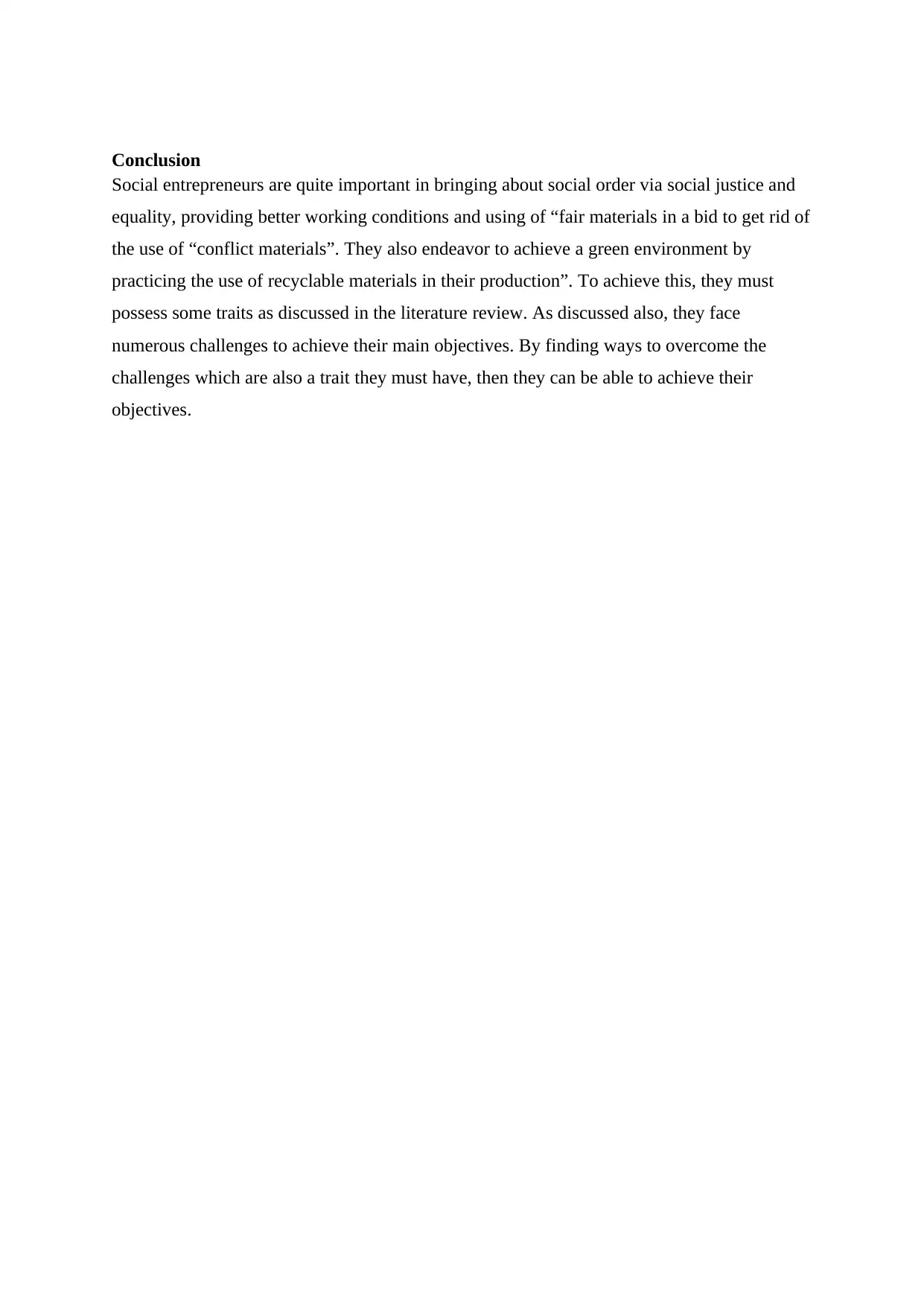
Conclusion
Social entrepreneurs are quite important in bringing about social order via social justice and
equality, providing better working conditions and using of “fair materials in a bid to get rid of
the use of “conflict materials”. They also endeavor to achieve a green environment by
practicing the use of recyclable materials in their production”. To achieve this, they must
possess some traits as discussed in the literature review. As discussed also, they face
numerous challenges to achieve their main objectives. By finding ways to overcome the
challenges which are also a trait they must have, then they can be able to achieve their
objectives.
Social entrepreneurs are quite important in bringing about social order via social justice and
equality, providing better working conditions and using of “fair materials in a bid to get rid of
the use of “conflict materials”. They also endeavor to achieve a green environment by
practicing the use of recyclable materials in their production”. To achieve this, they must
possess some traits as discussed in the literature review. As discussed also, they face
numerous challenges to achieve their main objectives. By finding ways to overcome the
challenges which are also a trait they must have, then they can be able to achieve their
objectives.
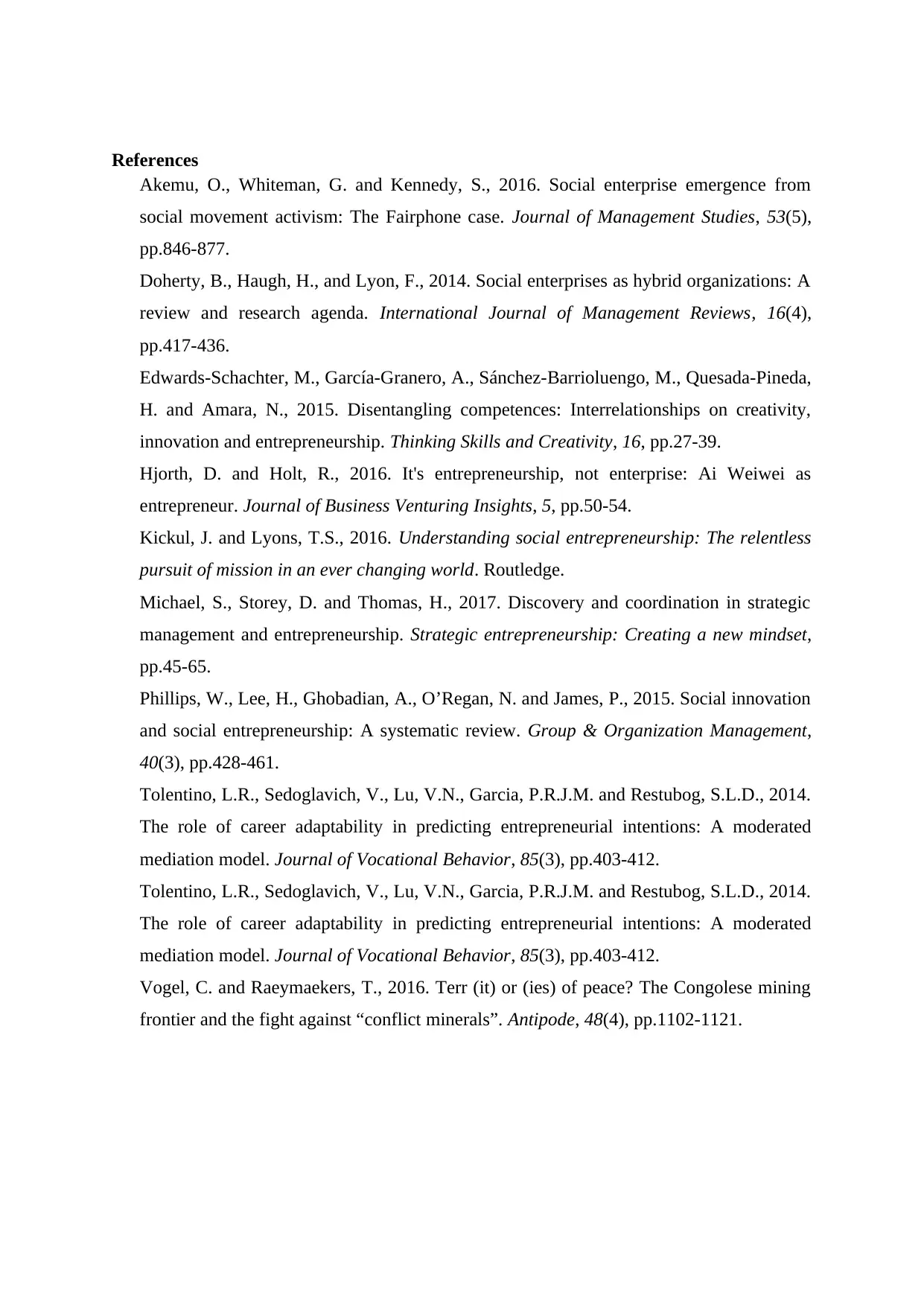
References
Akemu, O., Whiteman, G. and Kennedy, S., 2016. Social enterprise emergence from
social movement activism: The Fairphone case. Journal of Management Studies, 53(5),
pp.846-877.
Doherty, B., Haugh, H., and Lyon, F., 2014. Social enterprises as hybrid organizations: A
review and research agenda. International Journal of Management Reviews, 16(4),
pp.417-436.
Edwards-Schachter, M., García-Granero, A., Sánchez-Barrioluengo, M., Quesada-Pineda,
H. and Amara, N., 2015. Disentangling competences: Interrelationships on creativity,
innovation and entrepreneurship. Thinking Skills and Creativity, 16, pp.27-39.
Hjorth, D. and Holt, R., 2016. It's entrepreneurship, not enterprise: Ai Weiwei as
entrepreneur. Journal of Business Venturing Insights, 5, pp.50-54.
Kickul, J. and Lyons, T.S., 2016. Understanding social entrepreneurship: The relentless
pursuit of mission in an ever changing world. Routledge.
Michael, S., Storey, D. and Thomas, H., 2017. Discovery and coordination in strategic
management and entrepreneurship. Strategic entrepreneurship: Creating a new mindset,
pp.45-65.
Phillips, W., Lee, H., Ghobadian, A., O’Regan, N. and James, P., 2015. Social innovation
and social entrepreneurship: A systematic review. Group & Organization Management,
40(3), pp.428-461.
Tolentino, L.R., Sedoglavich, V., Lu, V.N., Garcia, P.R.J.M. and Restubog, S.L.D., 2014.
The role of career adaptability in predicting entrepreneurial intentions: A moderated
mediation model. Journal of Vocational Behavior, 85(3), pp.403-412.
Tolentino, L.R., Sedoglavich, V., Lu, V.N., Garcia, P.R.J.M. and Restubog, S.L.D., 2014.
The role of career adaptability in predicting entrepreneurial intentions: A moderated
mediation model. Journal of Vocational Behavior, 85(3), pp.403-412.
Vogel, C. and Raeymaekers, T., 2016. Terr (it) or (ies) of peace? The Congolese mining
frontier and the fight against “conflict minerals”. Antipode, 48(4), pp.1102-1121.
Akemu, O., Whiteman, G. and Kennedy, S., 2016. Social enterprise emergence from
social movement activism: The Fairphone case. Journal of Management Studies, 53(5),
pp.846-877.
Doherty, B., Haugh, H., and Lyon, F., 2014. Social enterprises as hybrid organizations: A
review and research agenda. International Journal of Management Reviews, 16(4),
pp.417-436.
Edwards-Schachter, M., García-Granero, A., Sánchez-Barrioluengo, M., Quesada-Pineda,
H. and Amara, N., 2015. Disentangling competences: Interrelationships on creativity,
innovation and entrepreneurship. Thinking Skills and Creativity, 16, pp.27-39.
Hjorth, D. and Holt, R., 2016. It's entrepreneurship, not enterprise: Ai Weiwei as
entrepreneur. Journal of Business Venturing Insights, 5, pp.50-54.
Kickul, J. and Lyons, T.S., 2016. Understanding social entrepreneurship: The relentless
pursuit of mission in an ever changing world. Routledge.
Michael, S., Storey, D. and Thomas, H., 2017. Discovery and coordination in strategic
management and entrepreneurship. Strategic entrepreneurship: Creating a new mindset,
pp.45-65.
Phillips, W., Lee, H., Ghobadian, A., O’Regan, N. and James, P., 2015. Social innovation
and social entrepreneurship: A systematic review. Group & Organization Management,
40(3), pp.428-461.
Tolentino, L.R., Sedoglavich, V., Lu, V.N., Garcia, P.R.J.M. and Restubog, S.L.D., 2014.
The role of career adaptability in predicting entrepreneurial intentions: A moderated
mediation model. Journal of Vocational Behavior, 85(3), pp.403-412.
Tolentino, L.R., Sedoglavich, V., Lu, V.N., Garcia, P.R.J.M. and Restubog, S.L.D., 2014.
The role of career adaptability in predicting entrepreneurial intentions: A moderated
mediation model. Journal of Vocational Behavior, 85(3), pp.403-412.
Vogel, C. and Raeymaekers, T., 2016. Terr (it) or (ies) of peace? The Congolese mining
frontier and the fight against “conflict minerals”. Antipode, 48(4), pp.1102-1121.
Paraphrase This Document
Need a fresh take? Get an instant paraphrase of this document with our AI Paraphraser

1 out of 11
![[object Object]](/_next/static/media/star-bottom.7253800d.svg)





